Welcome to the ultimate guide for crafting the most exquisite **Lemon Pound Cake Recipe** you’ll ever taste. From the first glance at its golden crust to the final, lingering notes of bright citrus on your palate, this cake is a true masterpiece of home baking. Imagine a cake so incredibly moist, so rich in buttery flavor, and perfectly balanced with the invigorating zest and tang of fresh lemons – it’s a culinary experience that truly does not disappoint. Each bite is a delightful journey, brimming with vibrant lemon goodness that makes it an instant classic.

There’s an undeniable magic to Lemon Desserts. The interplay of sweetness and tartness creates a harmonious flavor profile that is simply irresistible. This particular lemon pound cake elevates that experience, offering a comforting yet sophisticated treat that’s wonderful for any occasion. Beyond its incredible taste, this cake boasts a beautiful presentation, making it an ideal centerpiece for special gatherings. Whether you’re serving it for a delightful dessert after dinner, alongside a leisurely brunch, or as an elegant addition to a bridal shower or luncheon, its charm is undeniable.
Lemon-flavored treats are perennial favorites, especially as a refreshing Spring Dessert. If you adore citrus as much as we do, you’ll also cherish other easy lemon recipes like our Lemonade Pie, classic Lemon Cake, and simple Lemon Cake Mix Cookies. For those who enjoy a layered delight, our Lemon Lush Dessert is always a hit, while chocolate enthusiasts might prefer a rich Chocolate Pound Cake. But for pure citrus bliss, this lemon pound cake reigns supreme.
Table of Contents
- Why You’ll Adore This Recipe
- The Timeless Tradition of Pound Cake
- Essential Ingredients for Your Lemon Pound Cake
- For the Irresistible Cake Base
- For the Bright and Tangy Glaze
- Step-by-Step Guide: How to Make Lemon Pound Cake
- Baker’s Secrets: Pro Tips for Perfection
- Serving Suggestions and Creative Variations
- Frequently Asked Questions About Lemon Pound Cake
- Explore More Delectable Lemon Desserts
- Discover More Easy Cake Recipes
Why You’ll Adore This Recipe
This Lemon Pound Cake isn’t just another dessert; it’s a testament to simple, flavorful baking. Here’s why it’s destined to become a staple in your kitchen:
- A Quintessential Citrus Delight: Lemon desserts epitomize freshness, making them ideal for spring and summer, yet comforting enough for any season. This cake delivers an incredible burst of lemon flavor, perfectly complemented by its luscious, sweet-tart glaze – an absolute necessity for this lemon loaf.
- Versatile for Any Occasion: Its beauty and flavor make it suitable for a casual treat or an elegant gathering. Serve it unadorned for its pure deliciousness, or elevate it with a side of fresh berries, perhaps with an extra drizzle of the exquisite lemon glaze. It’s perfect for brunch, afternoon tea, or as a vibrant dessert.
- A Dream Come True for Lemon Enthusiasts: If you consider yourself a true lemon lover, then preparing this pound cake is a must. It’s wonderfully bright, intensely citrusy, and offers the ultimate lemon dessert experience. The balance of a dense, moist crumb with that zesty glaze is simply unparalleled.
The Timeless Tradition of Pound Cake
The pound cake holds a venerable place in baking history, with its origins tracing back to the 18th century. Its name is a direct reflection of its original recipe: one pound of butter, one pound of sugar, one pound of eggs, and one pound of flour. This straightforward, four-ingredient formula yielded a dense, rich, and incredibly satisfying cake that was beloved for its simplicity and luxurious texture. Over centuries, while the basic proportions might have been subtly adjusted for modern palates and baking techniques, the essence of the pound cake – its tender, fine crumb and comforting richness – remains. Our Lemon Pound Cake pays homage to this tradition, infusing the classic structure with the bright, refreshing essence of lemon, creating a contemporary favorite rooted in historical charm.
Essential Ingredients for Your Lemon Pound Cake
Crafting the perfect lemon pound cake begins with selecting quality ingredients. Each component plays a vital role in achieving that signature moist texture and unforgettable citrus flavor.
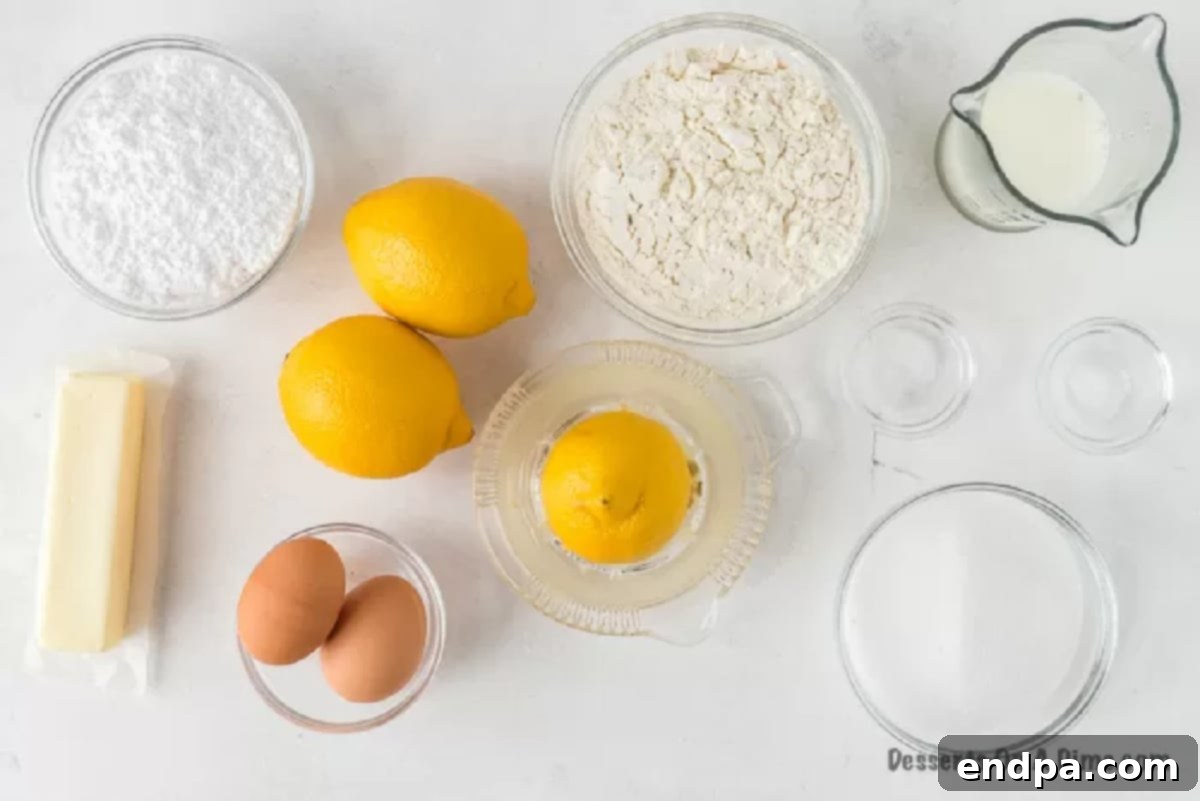
For the Irresistible Cake Base
- All-Purpose Flour: This is the structural backbone of our pound cake, providing a tender yet sturdy crumb. While some recipes suggest cake flour for a finer texture, all-purpose flour is widely accessible and performs beautifully in this recipe, delivering a wonderfully satisfying density.
- Baking Soda: Our leavening agent. When combined with acidic lemon juice and milk, it creates the gentle lift needed for a perfectly textured cake. If you ever find yourself without it, there are several baking soda substitutes you can explore in a pinch.
- Unsalted Butter: The secret to the rich flavor and melt-in-your-mouth texture of a true pound cake. Using unsalted butter allows you to control the overall saltiness of the recipe. Ensure it’s softened to room temperature for optimal creaming with sugar, which incorporates air for a lighter crumb.
- Large Eggs: These act as a binder, provide richness, and contribute to the cake’s structure and moisture. Using large eggs ensures the correct liquid-to-dry ingredient ratio for a consistent bake. Like butter, eggs should be at room temperature for better emulsion with other ingredients.
- Fresh Lemon Juice and Lemon Zest: These are the stars of the show, delivering that intense, vibrant lemon flavor. The zest holds aromatic oils that provide a bright, concentrated citrus punch, while the juice adds tang and moisture. Always use fresh lemons for the best results; bottled juice simply doesn’t compare.
- Whole Milk: Contributes to the cake’s richness and tender crumb. Its fat content helps create a truly moist and luxurious pound cake. Room temperature milk will blend seamlessly into the batter, preventing curdling.
For the Bright and Tangy Glaze
- Powdered Sugar (Confectioners’ Sugar): The base for our decadent glaze. Sifting the powdered sugar is a crucial step to prevent lumps, ensuring a smooth, velvety finish that beautifully coats the cake.
- Fresh Lemon Juice: Again, fresh is best! It provides the essential tartness and vibrant flavor for the glaze, cutting through the sweetness of the powdered sugar. Do not substitute with lemon extract, as it lacks the natural acidity and brightness of real lemon juice.
The complete, detailed list of ingredients with exact measurements can be found in the recipe card below, ensuring you have everything you need for this delightful bake.
Step-by-Step Guide: How to Make Lemon Pound Cake
Creating this delicious Lemon Pound Cake is a rewarding experience. Follow these steps for a perfect bake every time:
- Step 1 – Prepare Your Oven and Pan: Begin by preheating your oven to 350°F (175°C). Next, prepare your loaf pan. Lining it with parchment paper is highly recommended, allowing the paper to overhang on the sides for easy lifting. Alternatively, thoroughly spray the pan with a non-stick cooking spray. This crucial step ensures your beautiful loaf will slide out effortlessly after baking.
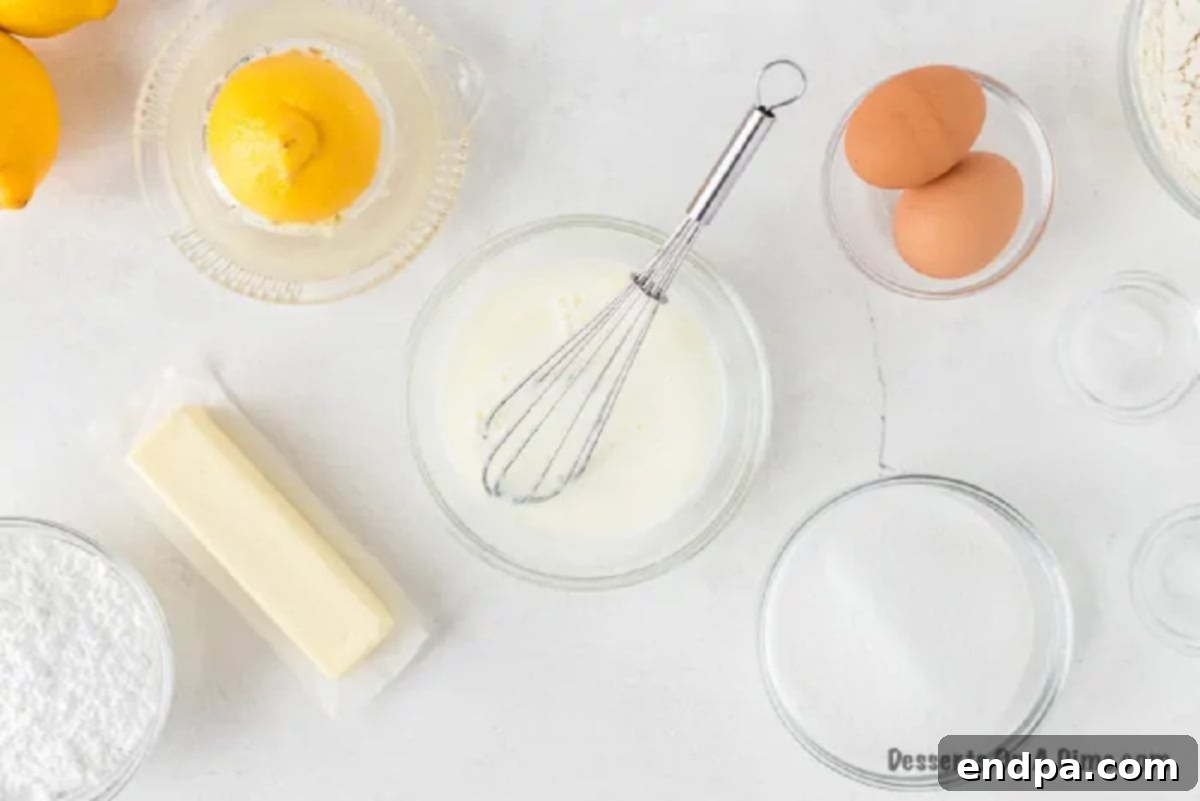
Step 2 – Combine Milk and Lemon Juice: In a small bowl, gently stir together the measured milk and fresh lemon juice. Set this mixture aside for a moment, as it will be incorporated into the batter later. The acidity from the lemon juice will slightly curdle the milk, mimicking buttermilk and contributing to the cake’s tender crumb.
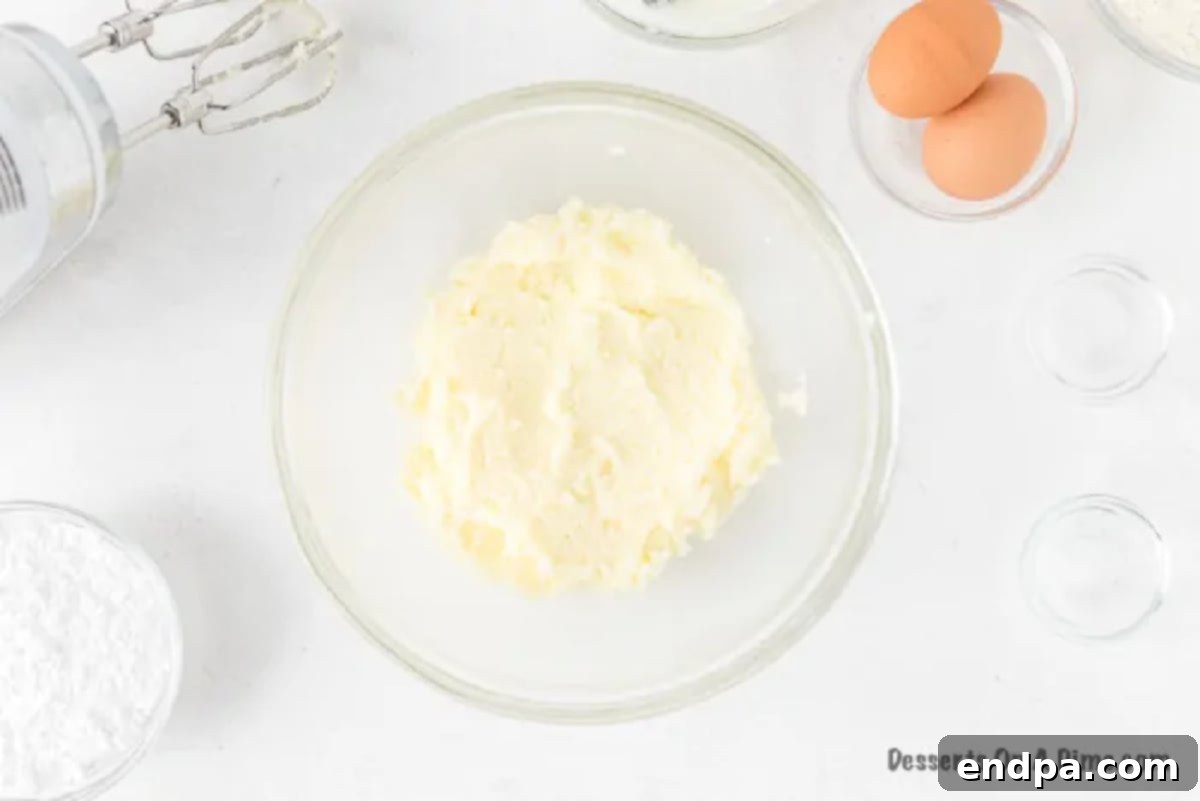
Step 3 – Cream Butter and Sugar: In a medium-sized mixing bowl, combine the softened butter and granulated sugar. Using either a stand mixer fitted with a paddle attachment or a hand mixer, beat the mixture on medium-high speed until it becomes light, fluffy, and pale in color. This creaming process incorporates air, which is essential for the pound cake’s texture.
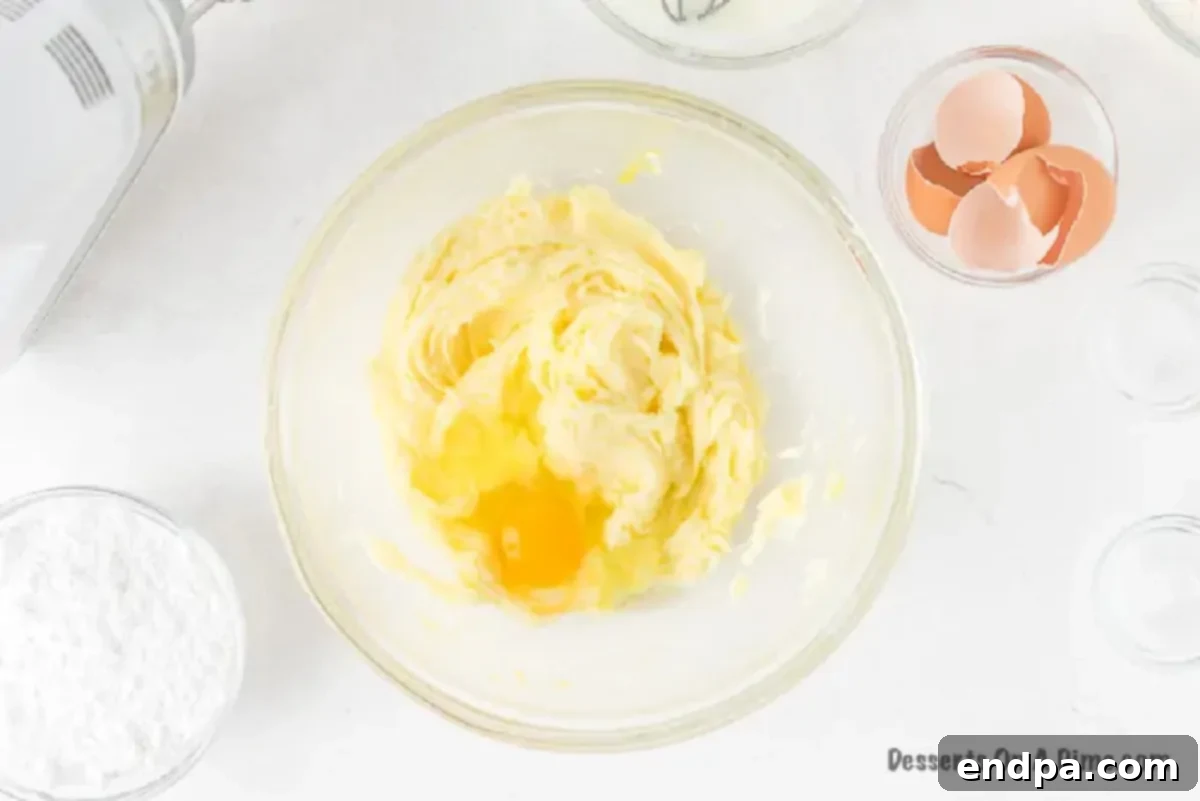
Step 4 – Incorporate Eggs and Lemon Zest: Add the large eggs to the butter and sugar mixture one at a time, beating well after each addition until fully incorporated. Scrape down the sides of the bowl as needed to ensure everything is evenly mixed. Once all eggs are added, stir in the fresh lemon zest, distributing its aromatic oils throughout the batter.
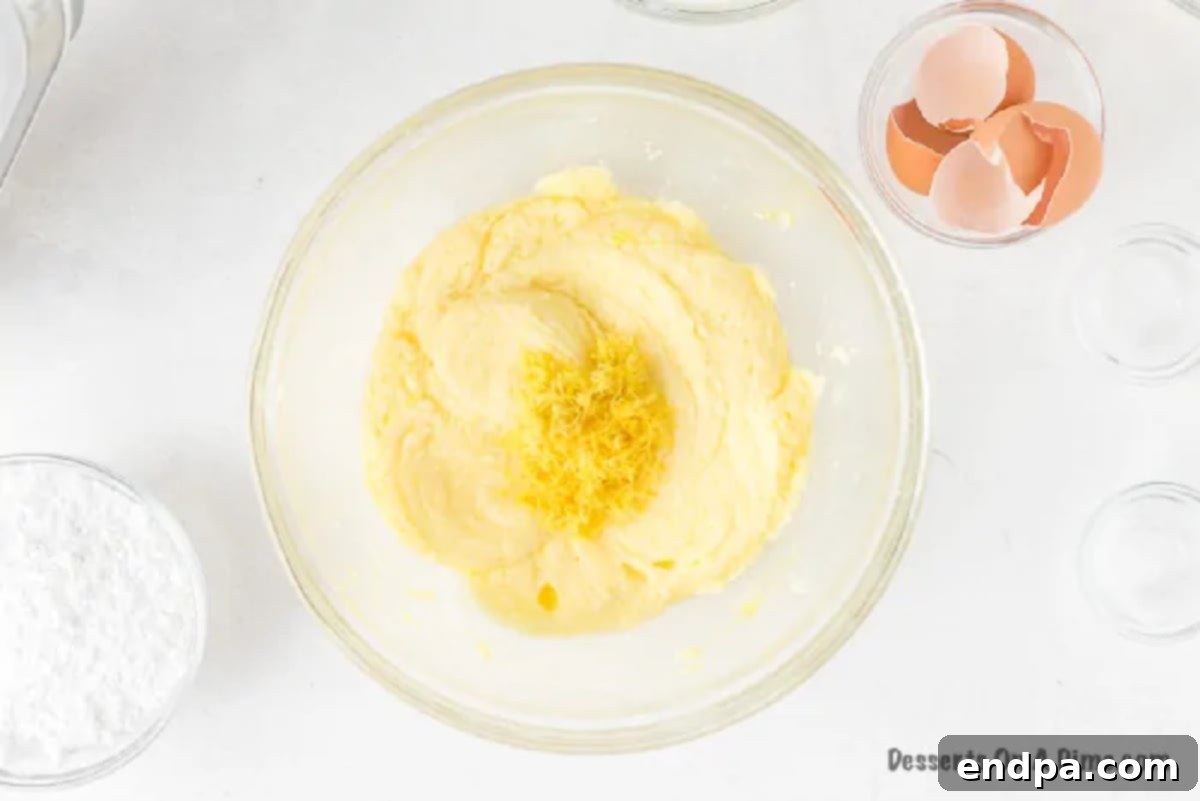
Step 5 – Mix Dry Ingredients: In a separate, clean bowl, whisk together the dry ingredients: all-purpose flour, salt, and baking soda. Ensure they are thoroughly combined to guarantee even distribution in the cake batter.
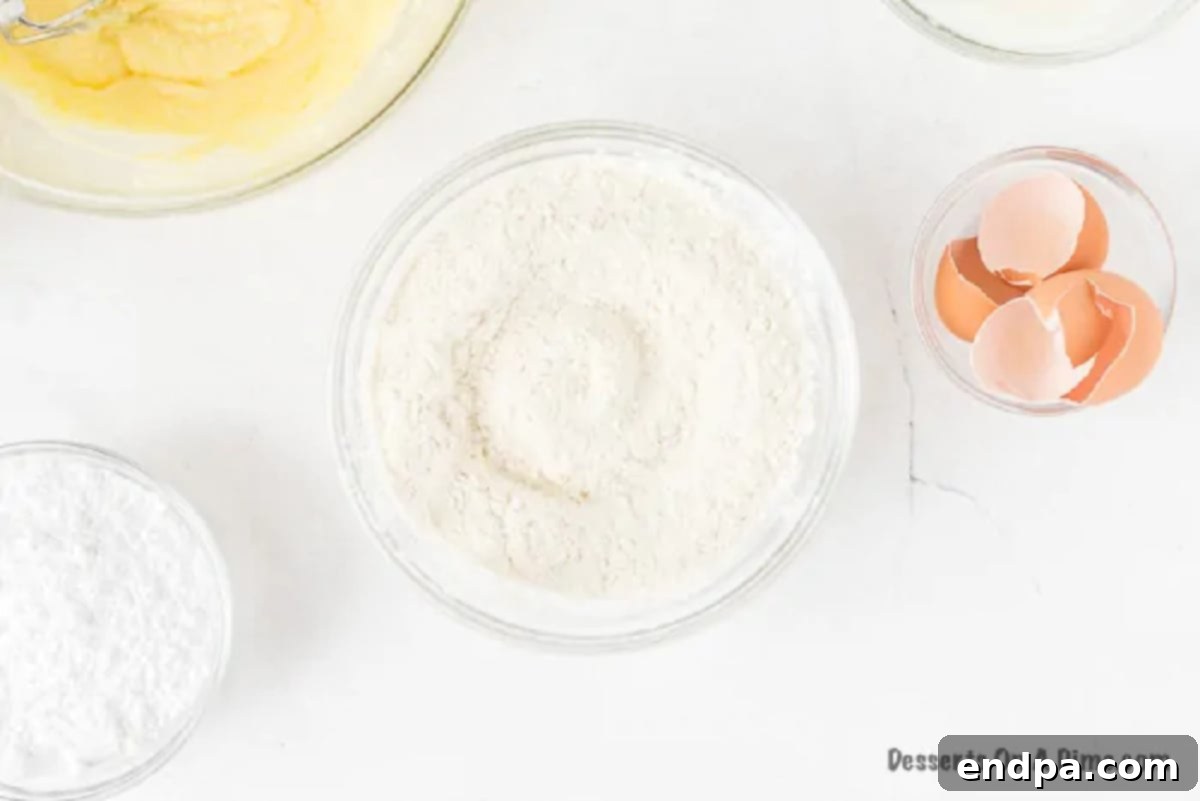
Step 6 – Combine Wet and Dry Mixtures: Gradually add the flour mixture and the prepared milk-lemon juice mixture to the creamed butter and sugar, alternating between the two. Begin and end with the flour mixture. Mix on low speed, just until the ingredients are combined and no streaks of flour remain. Be careful not to overmix, which can lead to a tough cake.

Step 7 – Bake the Cake: Pour the luscious cake batter into your prepared loaf pan, spreading it evenly. Bake in the preheated oven for 50-60 minutes. The cake is done when a toothpick inserted into the center comes out clean or with just a few moist crumbs attached.

Step 8 – Cool the Cake: Once baked, remove the loaf pan from the oven and let the cake cool in the pan for about 10-15 minutes. This allows the cake to set and prevents it from crumbling. Then, carefully transfer the cake from the pan to a wire rack to cool completely. Patience is key here; applying glaze to a warm cake will result in a runny, absorbed mess.
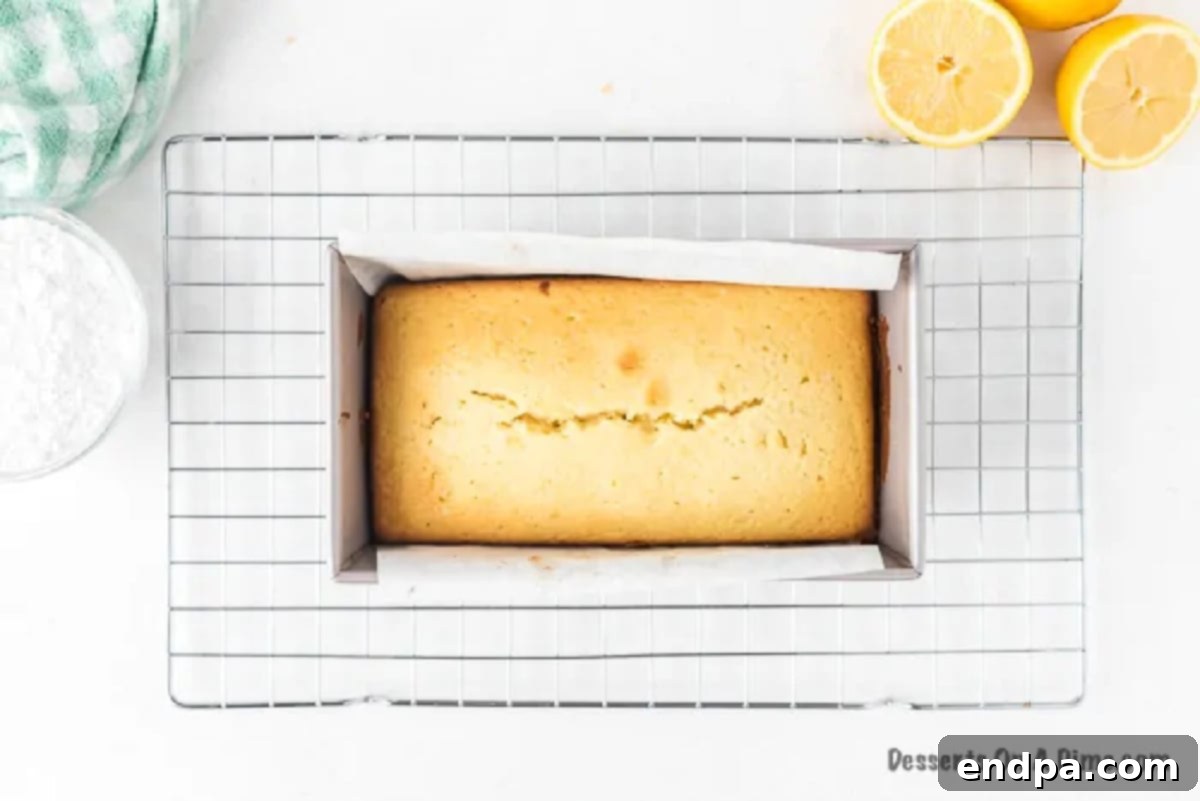
Step 9 – Prepare the Lemon Glaze: While the pound cake is cooling, prepare the vibrant lemon glaze. In a medium-sized bowl, whisk together the sifted powdered sugar and fresh lemon juice until smooth and free of lumps. Adjust the consistency by adding a tiny bit more powdered sugar for a thicker glaze or a few drops of lemon juice for a thinner one.

Step 10 – Glaze and Serve: Once the cake is completely cooled to room temperature, generously pour the prepared lemon glaze evenly over the top. Allow the glaze a few minutes to set before slicing and serving. Enjoy your homemade, utterly delicious lemon pound cake!

Step 11 – Admire and Enjoy: Take a moment to appreciate your beautiful creation! The glossy lemon glaze adds both visual appeal and an extra layer of citrusy sweetness. Slice into thick pieces and savor every single bite of this moist and flavorful treat. Perfect with a cup of tea or coffee!

Baker’s Secrets: Pro Tips for Perfection
Achieving a truly outstanding lemon pound cake is easy with these expert tips:
- Proper Pan Preparation is Key: Don’t underestimate the importance of preparing your baking pan. Whether you choose to line your loaf pan with parchment paper, leaving an overhang to easily lift the cake out, or meticulously coat it with cooking spray, proper preparation prevents sticking and ensures your beautiful loaf emerges intact.
- Mindful Mixing: While it’s important to ensure ingredients are thoroughly combined, overmixing is a common pitfall. Once the flour mixture is added, mix only until just combined. Overmixing develops gluten, which can lead to a tough, less tender cake. A gentle hand, whether mixing by hand or with an electric mixer, is best.
- Embrace Room Temperature Ingredients: This is a golden rule in baking, especially for pound cakes. Butter, eggs, and milk at room temperature emulsify better, meaning they blend together smoothly to create a uniform, lump-free batter. This perfect emulsion is crucial for achieving that desirable light, airy texture and fine crumb. Cold ingredients can cause the batter to curdle or become lumpy, affecting the final texture.
- Patience for the Glaze: Always allow your lemon loaf to cool completely to room temperature before applying the glaze. Pouring glaze over a warm cake will cause it to melt and absorb into the cake, rather than forming a beautiful, glistening layer on top.
- Accurate Doneness Check: To confirm your lemon loaf is perfectly baked, insert a toothpick into the very center of the cake. If it comes out clean or with only a few moist crumbs attached, it’s ready. If it’s still wet, continue baking in short intervals.
- Pan Size Flexibility: While this recipe is designed for a loaf pan, feel free to experiment with other bakeware. A Bundt cake pan can also be used, though baking times may vary. Adjust cooking time and monitor for doneness.
- Mini Loaves for Gifting: For a charming touch, consider baking this recipe in mini loaf pans. These smaller versions are adorable and make fantastic homemade gifts for friends, neighbors, or coworkers. Wrap them in cellophane and tie with a festive ribbon for a thoughtful present.
- Glaze Consistency Control: The perfect glaze is a matter of personal preference. It’s important to adjust the glaze consistency accordingly. If your glaze is too thick, add a tiny bit more lemon juice, a few drops at a time. If it’s too thin, sift in a little more powdered sugar until you reach your desired pourable, yet thick, consistency.
- Preventing Over-Browning: Keep an eye on the top of your lemon loaf as it bakes. If it begins to brown too quickly before the center is cooked through, lightly cover it with aluminum foil. This will protect the top from excessive browning while allowing the inside to continue baking to perfection.
Serving Suggestions and Creative Variations
This Lemon Pound Cake is wonderful on its own, but its versatility allows for delightful pairings and variations:
- Classic Pairing: Serve slices with a dollop of freshly whipped cream and a handful of seasonal berries like raspberries, blueberries, or sliced strawberries. The tartness of the berries beautifully complements the lemon.
- Brunch Favorite: A slice of lemon pound cake with a cup of coffee or herbal tea makes for an elegant and satisfying brunch item.
- Dessert Platter: Cut into small squares and arrange on a dessert platter with other treats for a party.
- Infused with Herbs: For an adventurous twist, infuse the milk with a sprig of fresh rosemary or thyme before mixing into the batter. Strain out the herbs before using the milk.
- Almond Delight: Add 1/2 teaspoon of almond extract to the cake batter and sprinkle slivered almonds on top of the glaze for a nutty flavor profile.
- Poppy Seed Perfection: Stir 2 tablespoons of poppy seeds into the batter for added texture and a classic lemon-poppy seed combination.
- Different Citrus: While lemon is king here, you can experiment with other citrus zests and juices, such as lime or orange, for a different flavor profile.
Frequently Asked Questions About Lemon Pound Cake
Here are answers to common questions about making and storing this delightful lemon pound cake:
How to freeze pound cake?
Freezing pound cake is an excellent way to enjoy it later. For an entire loaf, wrap it tightly in several layers of plastic wrap, then place it in a freezer-safe bag or aluminum foil. It can be stored in the freezer for up to 3-4 months. To thaw, simply place it on the counter at room temperature for several hours or overnight until it’s soft and ready to serve. A smart alternative is to freeze individual slices. This way, you can grab a single serving whenever a craving strikes without thawing the entire cake. Simply wrap each slice individually before freezing. Consider doubling the recipe to have one loaf for immediate enjoyment and another to stock your freezer – it requires minimal extra effort! You can find more comprehensive tips on freezing cakes here.
What is the best flour to use for pound cake?
For this particular lemon pound cake recipe, we’ve found that all-purpose flour works wonderfully, providing a classic, hearty texture. However, for an even tenderer and moister crumb, some bakers prefer to use cake flour. Cake flour has a lower protein content than all-purpose flour, which results in a softer, more delicate texture. If you opt for cake flour, you might need to adjust the liquid slightly as it absorbs differently. Both options yield delicious results, so choose what you have on hand or what you prefer for texture.
How to store lemon pound cake?
This lemon loaf is quite resilient and stores beautifully at room temperature. To keep it fresh and moist, place it in an airtight container immediately after the glaze has set. Stored properly, it will retain its delicious flavor and texture for about 5-7 days. Avoid refrigerating the pound cake unless it contains a perishable filling, as the cold can dry out the cake and alter its texture. If you do need to refrigerate it, wrap it extra tightly and bring it back to room temperature before serving for the best experience.
Why is my pound cake dry?
A dry pound cake is usually a result of overbaking or not enough moisture. Ensure you’re measuring your flour accurately (by weight if possible, or using the spoon-and-level method). Also, be careful not to overmix the batter once the flour is added, as this can develop gluten and lead to a tough, dry cake. Finally, always test for doneness with a toothpick and remove the cake from the oven as soon as it’s ready.
Can I make this in a Bundt pan?
Absolutely! This recipe can easily be adapted for a Bundt pan. Make sure to thoroughly grease and flour your Bundt pan to prevent sticking. The baking time will likely be similar, but it’s crucial to monitor it closely, as Bundt cakes can sometimes bake a little faster or slower depending on the pan’s material and size. Always use the toothpick test for doneness.
Explore More Delectable Lemon Desserts
If you’re a true connoisseur of citrus, our collection of lemon desserts is sure to delight:
- Lemon Cake Recipe
- Copycat Starbucks Lemon Loaf Recipe
- Easy Lemon Poke Cake Recipe
- Lemon Cheesecake Bars Recipe
- 2 Ingredient Lemon Bar Recipe
- Lemon Icebox Pie Recipe
Discover More Easy Cake Recipes
For those who love to bake and enjoy a slice of homemade goodness, check out these other easy and delicious cake recipes:
- Easy Pound Cake Recipe
- Chocolate Cherry Dump Cake Recipe
- 7 Up Cake Recipe
- Chocolate Depression Cake
- Chocolate Bundt Cake Recipe
This Lemon Pound Cake is truly the perfect recipe for anyone who adores the rich, comforting texture of pound cake combined with the bright, tangy burst of lemon. It’s simple enough for novice bakers and satisfying enough for seasoned pros. Give it a try today, and let us know your thoughts in the comments!
Pin
Lemon Pound Cake Recipe
Ingredients
- FOR THE CAKE:
- 1 1/2 cup Flour
- 1/2 tsp Salt
- 1/4 tsp Baking Soda
- 1/2 cup Butter softened at room temperature
- 1 cup Sugar
- 2 Large Eggs
- 3 Tbsp Lemon Juice
- 1 Tablespoon Lemon Zest approximately from 3 lemons
- 1/2 cup Milk
- FOR THE GLAZE:
- 1 cup Powder sugar
- 2 Tbsp Lemon Juice
Instructions
- Preheat the oven to 350 degrees F and line a 9 inch loaf pan with parchment paper or spray with a non-stick cooking spray.
- In a small bowl, stir together the milk and lemon juice. Then set aside.
- In a large bowl, cream together the butter and sugar together with a hand held or stand up mixer until the mixture is light and fluffy.
- Slowly add in the eggs into the mixture one of time mixing in between each egg. Then stir in the lemon zest.
- In a separate bowl, combine the flour, salt and baking soda.
- Then add the flour and milk mixtures alternatively into the butter and sugar mixture stirring as you go.
- Pour the mixture into the loaf pan and bake uncovered for 50-60 minutes until a toothpick inserted into the middle of the cake comes out clean.
- Let the cake cool for 10-15 minutes in the pan and then move to a wire rack to cool completely.
- While the cake is cooling, prepare the glaze by whisking together the powdered sugar and lemon juice in a medium size bowl.
- Once the cake has cooled, pour the glaze over the top, slice and enjoy!
Recipe Notes
Nutrition Facts
Pin This Now to Remember It Later
Pin Recipe
